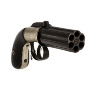Revolver.45
Member
- Joined
- Jan 29, 2020
- Messages
- 11
Hello.
I’ve seen old black powder revolvers with very thin cylinder wall thickness, like these cylinders for example:

and this pepperbox has also resonable thin walls:

Back in the days the quality of steel was inferior, so it got me to wounder about the steels of today.
What’s the minimum (with a safety factor) thickness of a chamber (or overall barrel for a pepperbox or derringer) in cal .40 containing a 25-30 grain FFFG black powder (or equivalent pyrodex P) load with a 92 grain lead roundball tightly infront of it (+wadding) if it’s made out of a steel with following properties:
Yield strength min [MPa]
700
Tensile strength [MPa]
900-1050
Elongation A5 [%]
12
Hardness
270-325 HB
And how many PSI will such a load described above generate?
I’ve seen old black powder revolvers with very thin cylinder wall thickness, like these cylinders for example:

and this pepperbox has also resonable thin walls:

Back in the days the quality of steel was inferior, so it got me to wounder about the steels of today.
What’s the minimum (with a safety factor) thickness of a chamber (or overall barrel for a pepperbox or derringer) in cal .40 containing a 25-30 grain FFFG black powder (or equivalent pyrodex P) load with a 92 grain lead roundball tightly infront of it (+wadding) if it’s made out of a steel with following properties:
Yield strength min [MPa]
700
Tensile strength [MPa]
900-1050
Elongation A5 [%]
12
Hardness
270-325 HB
And how many PSI will such a load described above generate?

